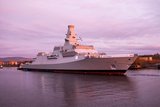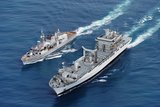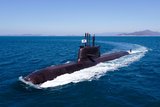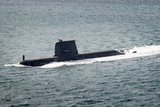Northrop Grumman’s Manta Ray completes testing
The Northrop Grumman Manta Ray being towed out for trials. (Photo: Northrop Grumman)
Northrop Grumman has completed full-scale, in-water testing of its Manta Ray UUV which will be developed for the US DoD’s Defense Advanced Research Projects Agency (DARPA).
Testing took place in February and March off the coast of southern California during which it demonstrated at-sea hydrodynamic performance, including submerged operations, so that the vehicle’s modes of propulsion and steering, buoyancy, propellers and control surfaces could all be evaluated.
The company shipped the Manta Ray prototype in subsections from the build location in Maryland as part of an effort to demonstrate transportability and capability to be deployed worldwide with limited support.
The programme will aim to develop and demonstrate a new class of long-duration, long-range, payload-capable UUVs for persistent operations in dynamic maritime environments. DARPA and the US Navy have been working on designing the next steps for testing and transition of the technology.
Dr Kyle Woerner, programme manager for Manta Ray at DARPA, said: “Our successful, full-scale Manta Ray testing validates the vehicle’s readiness to advance toward real-world operations after being rapidly assembled in the field from modular subsections.
“Once deployed, the vehicle uses buoyancy-driven gliding to move through the water,” Woerner continued. “The craft is designed with several payload bays of multiple sizes and types to enable a wide variety of naval mission sets.”
Related Equipment in Defence Insight
More from Naval Warfare
-
![UK MoD’s confirmation of MBDA missile for Type 26 points to more European collaboration]()
UK MoD’s confirmation of MBDA missile for Type 26 points to more European collaboration
The Type 26 will also be fitted with the Sea Ceptor vertically launched air defence system that can fire CAMM missiles and a 24-cell Mk 41 vertical launch system that can fire the Tomahawk land-attack cruise missiles, anti-submarine rockets and long-range anti-ship missiles.
-
![Second Royal Canadian Navy Joint Support Ship is on schedule to be launched mid-2026]()
Second Royal Canadian Navy Joint Support Ship is on schedule to be launched mid-2026
While the first Joint Support Ship is currently in the final stages of outfitting, the second one is on schedule for launching next year.
-
![Is South Korea finally being taken seriously for Western submarine programmes?]()
Is South Korea finally being taken seriously for Western submarine programmes?
South Korean shipbuilders are beginning to make their mark beyond Asia, competing for major North American and European submarine programmes and becoming serious contenders on a global scale.
-
![AUKUS Pillar 2 could narrow focus to “four key areas” says UK official]()
AUKUS Pillar 2 could narrow focus to “four key areas” says UK official
Few concrete ideas have emerged so far on which “advanced capabilities” will be brought forward under Pillar 2 of the AUKUS partnership, but the Pentagon’s review of the programme could bring more clarity.






















